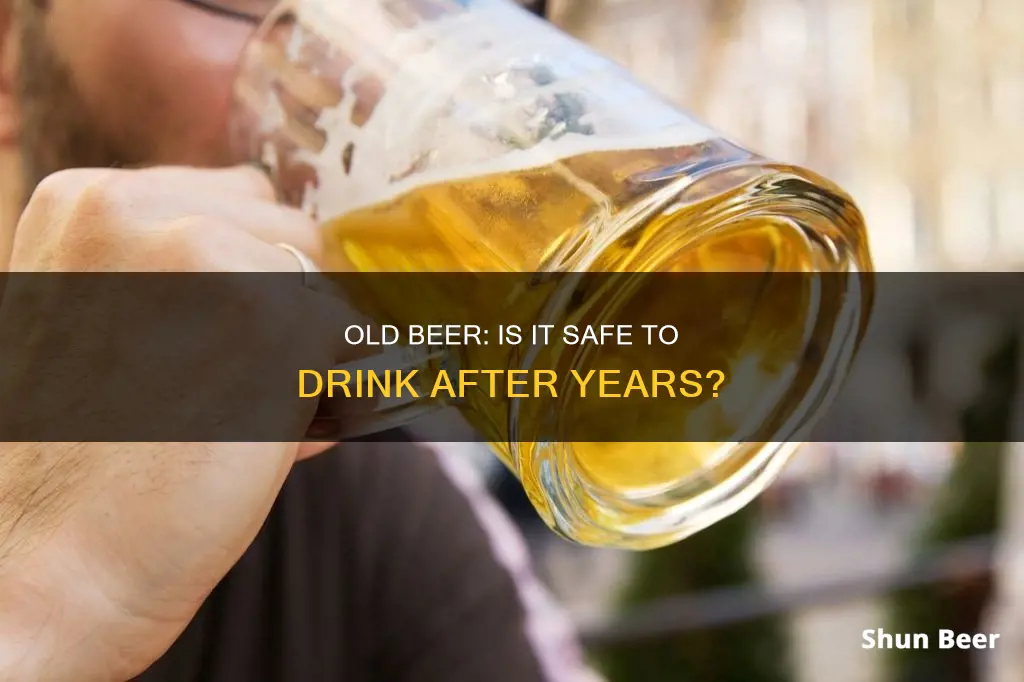
Beer is often believed to be unsafe for consumption if consumed past its best before date. However, this is not necessarily true. Beer doesn't expire and can be consumed years after it was brewed, as long as it is sealed, preventing bacteria from getting to the beer. Although drinking old beer is mostly safe, it might not taste very good. The flavour of the beer deteriorates over time, and the older the beer, the worse it tastes.
| Characteristics | Values |
|---|---|
| Safety | Drinking 8-year-old beer is not harmful or dangerous, even if it is past its "sell by" date. |
| Taste | The beer will probably not taste good. It will likely have an off flavour, such as cardboard or skunk, and a thin body. |
| Carbonation | If there are bubbles, the beer is likely airtight. |
What You'll Learn

Is 8-year-old beer harmful to drink?
It is generally agreed that drinking old beer is not harmful to your health. However, it is also unlikely to taste good.
The flavour of beer deteriorates over time, particularly in light body, low ABV beers. The rate of flavour deterioration depends on the packaging of the beer. Canned beer will do much better than bottled beer over time, as it prevents light from entering and maintains an airtight seal better. Beer bottles that are darker in colour are better at preventing UV light from reaching the beer and "skunking" it. However, even dark bottles let some UV light through, and the seal on the caps of beer bottles can break down over time and allow air into the bottle.
The temperature at which the beer is stored will also impact the rate at which the flavour changes. It is best to keep beer under 50 degrees and stored in a refrigerator, with a consistent temperature.
Overall, light, low ABV beers will see their flavour impacted much faster than dark, high ABV beers. If a beer is just a few months past its expiration date, you probably won't notice a huge difference. But when you let it sit for years, you are bound to find that a lot has changed.
In conclusion, while it is not harmful to drink 8-year-old beer, it is unlikely to taste good. The flavour of the beer will have deteriorated, and it may taste stale, cardboardy, or skunky.
Beer Sales Strategies During Doubleheaders
You may want to see also

Does old beer taste good?
Whether old beer tastes good depends on a variety of factors, including the type of beer, how it was stored, and personal taste.
Firstly, the type of beer is important. Light body, low ABV beers tend to have their flavour deteriorate faster than darker, high ABV beers. So a 10% ABV Imperial Stout will handle years of ageing, while a 4% American Lager will see flavour changes in the first year. Beers with yeast in the bottle also tend to age well.
Secondly, how the beer is packaged and stored will impact its flavour over time. Canned beer will do much better than bottled beer over extended periods, as it prevents light from entering and maintains an airtight seal better. Beer bottles can be dark brown, green, or clear, with the darker colours preventing more UV light from reaching the beer and "skunking" it. Beer should be stored in a cool, consistent, dark area, preferably in the refrigerator, and away from direct sources of heat or light.
Finally, personal taste will determine whether an old beer tastes good. Some people enjoy the flavours that develop in aged beers, while others find them unappealing. Aged beers may taste flat, sweet, malty, stale, bitter, sour, or strong.
Breaking into the Beer Industry: A Guide to Success
You may want to see also

What factors impact the flavour of beer over time?
It is possible to drink beer that is several years old, but it may not taste very good. The flavour of beer can be influenced by several factors, and these factors can cause the beer to taste different over time. Here are some of the key factors that can impact the flavour of beer:
Ingredients
The basic ingredients of beer are water, malt, hops, and yeast. The quality of these ingredients and the ratio in which they are mixed will affect the beer's flavour. Malt, for example, gives beer its sweetness, body, and colour when roasted, and different malts can provide a variety of flavours, such as caramel, chocolate, and coffee. Hops add bitterness and balance the sweetness of the beer, while different hop varieties can contribute floral, fruity, or herbal notes. Yeast plays a crucial role in converting the sugar in the malt into alcohol and carbon dioxide, and different yeast strains can produce different flavours and aromas, such as fruity, spicy, or funky flavours.
Fermentation
The process of fermentation can also impact the flavour of beer. The length of fermentation, the temperature, and the type of yeast used can all influence the final taste of the beer.
Aging
Aging can have a significant impact on the flavour of beer, and some styles of beer, such as stouts, porters, and barley wines, are particularly affected. While some beers benefit from aging, others can lose their fresh flavours and spoil quickly. The length of aging can affect the flavour profile, with decreased bitterness and increased sweet/caramel, black currant, toffee, and sherry-like aromas.
Storage and Shipping Conditions
The conditions under which beer is stored and shipped can also affect its flavour. Beer that is shipped and stored under refrigeration is more likely to stay fresh up to its anticipated shelf life. However, this can add cost and may not always be feasible. Most beers have expected shelf lives of 17-26 weeks, with imports having longer shelf lives and draughts having shorter ones (9-13 weeks). The storage temperature also plays a role, with each day stored above 75°F resulting in a loss of up to two days of shelf life for a typical domestic lager.
Oxygen, Light, Temperature, and Time
Beer ageing is susceptible to its four main enemies: oxygen, light, temperature, and time. These factors can cause chemical reactions that impact the flavour of the beer. For example, oxidation can lead to decreased bitterness and increased sweet and caramel flavours. Light exposure can cause a reaction between iso-alpha acids degradation products and sulphur in the beer, resulting in a "skunky" character.
In summary, the flavour of beer is influenced by a complex interplay of factors, including ingredients, fermentation, aging, and storage conditions. These factors can cause the beer to evolve and change over time, resulting in a dynamic and ever-changing beverage.
Millenials' Work Culture: Beer on the Job?
You may want to see also

How do I know if old beer is safe to drink?
It's important to note that all beers don’t age the same way. The shelf life of a beer has a lot to do with its ABV composition and how it has been packaged and stored.
Higher ABV beers (8% and above) like stouts and barley wines taste better with age, so leaving them on the shelf for a few years is ideal, provided you take careful steps to store them properly.
Opened beer will naturally have a shorter lifespan as it goes flat once you break the airtight seal, even if you refrigerate it.
As a general rule of thumb, sealed beer is shelf-stable for 6 to 8 months without refrigeration. If stored and refrigerated properly, sealed beer can last beyond its expiration date for up to 12 months.
There are three main factors that cause beer to lose its quality: light exposure, oxygen exposure, and bacteria exposure.
Exposure to ultraviolet (UV) rays can cause the hop-derived compounds in your beer to break down and combine with a sulphuric compound, releasing an odour similar to that of a skunk. Keep in mind that the more hops in a recipe, the higher the chances of the beer skunking.
Oxidation is a chemical reaction that takes place when oxygen molecules interact with the molecules of your beer and the other ingredients that impart flavour to your drink. In dark beers, oxidation converts malt flavours to those of rotting fruit or sherry. In light-coloured beer, oxidation will remove all the hoppy, malty flavours, leaving it to taste like wet paper.
Bacterial infections in beer are rare because the alcohol content in beer acts as a natural preservative, making it extremely difficult for bacteria to survive and thrive. However, if bacteria find a way to get into your beer, it will start eating away at it.
- If there is an absence of the signature hissing sound when you open it, it means the beer has lost its carbonation.
- If your beer doesn't form white foam rising to the top and spilling over when you open it, it has likely gone flat.
- If the label on the bottle is dusty, it's probably been sitting on the shelf for a while.
- If there are sediments settled at the bottom of the bottle, it’s probably best to avoid drinking the beer. However, in some beer styles such as German Weissbier and Belgian Dubbel, yeast sediments are not considered a flaw.
- Check for leakage around the sealed mouth of the bottle, which may indicate that the bottle and its contents have been subjected to high levels of heat at some point.
- If all else fails, just take a sip. You’ll taste the flatness, 'off' flavours, and skunky aromas right away, and know that your beer has lost its quality.
If you want to store your beer for later, make sure you take the right steps to store it well so it doesn’t lose its carbonation or turn skunky. Here are some tips to ensure your beer lasts:
- Refrigerate it: Refrigeration not only keeps your beer cold but also protects it from direct sunlight. The ideal temperature for beer storage is between 50 and 55 degrees Fahrenheit. Sealed bottles and cans can be stored in colder conditions.
- Store it in a dark place: If you choose to keep your beer at room temperature, pick a cool, dark room that undergoes minimal temperature fluctuations. Basements are a great choice for storing beer.
- Keep it standing upright: When you keep beer lying on its side, you allow a larger surface area to be exposed to oxidation. Beer that’s left to stand upright will only expose the top surface of the beer to air or unnecessary oxidation.
Beer before work: Is it illegal or not?
You may want to see also

What's the best way to store beer?
While it's not advisable to drink 8-year-old beer, it's unlikely to be harmful to your health. However, it's probably going to taste bad. If you're thinking of ageing your beer, there are several factors to consider. Firstly, check the ABV; if it's higher than 8%, you don't need to worry about drinking it quickly. Sour and smoked beers also fall into this category. However, IPAs and other hop-centric beers, like amber lagers and American pale ales, will age quickly, even if they have a high ABV. Most craft breweries in America don't pasteurize their beers, so their shelf life is shorter than mass-produced lagers, which are pasteurized.
If you're not planning on ageing your beer, it's best to drink it within three months of the bottling date. Keep it in the fridge during those three months, as the aging process starts as soon as beer is made. Keeping it cold will slow down the advancing of flavours and oxidation. If you don't have fridge space, store it in a dark, cool place, like a basement or a closet.
Make sure to store your beer upright, as this will minimize the amount of the beer's surface area that will be touching the air trapped in the bottle. Less air contact means less oxidation of the beer, preventing it from breaking down more quickly.
To improve the shelf life of your beer, keep it away from sunlight and fluorescent light so that it doesn't 'skunk'. This is because a chemical reaction releases sulfur compounds found in bitter hops, which smell like a skunk's spray.
Beer Collectables: A Guide to Their Functionality and Value
You may want to see also
Frequently asked questions
Drinking 8-year-old beer is unlikely to be harmful to your health, but it might not taste very nice.
Old beer might taste like cardboard, or be "skunked" (a result of exposure to light).
The type of beer, how it was packaged, and how it was stored can all affect the taste of old beer.
Beer should be stored in a cool, dark, and consistent environment. Canned beer is better for long-term storage than bottled beer, as it lets in less light and oxygen.
Yes, beer doesn't usually have a genuine expiry date, so it's fine to drink past its "best before" date. However, the taste may have deteriorated.







